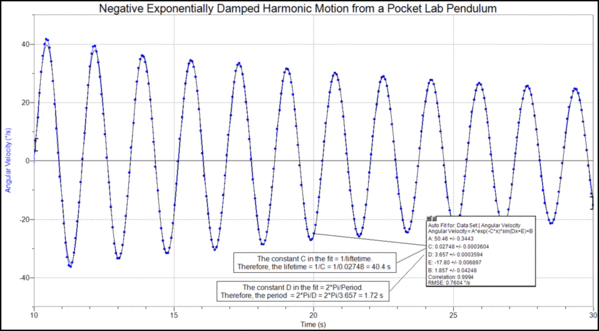This experiment allows one to do a quantitative investigation of the damped harmonic motion of a swinging pendulum. The pendulum is a piece of wood about a yard long from a Michael's hobby shop one end of which has been attached to a PocketLab by a rubber band. The other end is taped to the top of a doorway, allowing the resultant pendulum to swing back-and-forth as shown in the image below.

The y-axis is perpendicular to the XZ plane of the swinging pendulum. Therefore, the main item of interest is the magnitude of the angular velocity vector in the Y direction (shown as a blue curve in the movie).
The image shown below contains a graph of the Y angular velocity (shown in blue). The X and Z angular velocities (shown in red and green in the video, respectively) are small and erratic due to slight wobble in the swinging pendulum and are not included in the graph. The graph was obtained by importing the data from the PocketLab app into Logger Pro, an exceptional educational scientific analysis software from Vernier Software & Technology (vernier.com). A model involving the sine function and the exponential function was created. It is seen that the model (the black curve) follows the blue angular velocity curve very well.

Students can therefore conclude that this damped harmonic motion has a negative exponential decay with individual cycles characteristic of the sine function. There are two constants of particular interest in the model equation shown in the gif image: Angular Velocity = A*exp(-C*x)*sin(Dx+E)+B. The constant D in the fit is 2*Pi/Period, from which we see that the period is 2*Pi/D = 2*Pi/3.657 = 1.72 s. This agrees very well with the period obtained by direct observation of the graph. The constant C in the fit is the reciprocal of the so-called lifetime. Any exponential decay is characterized by its lifetime, which is the amount of time required for the amplitude to decay to 37% of its initial value.
You will note from observing the movie that the angular Y velocity is zero when the pendulum is at the two ends of its swing, and is a maximum at the middle of the swing, both of which are expected. This is easier to see if you view the movie frame by frame.

